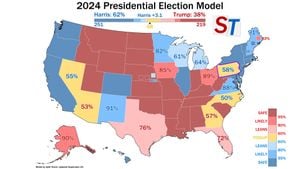Frustrated Americans await the economic changes they voted for with Donald Trump. Fed up with high prices and unimpressed with what many see as a healthy economy—by standard measures—voters are longing for the return of the economic stability they associate with Trump's first term.
When Donald Trump campaigned for president again, he spoke passionately about toppling the Biden administration's economic policies. His debate promises of imposing hefty tariffs on foreign goods, slashing taxes for both individuals and businesses, and deporting millions of undocumented workers struck chords with those who felt ignored and economically burdened. Millions cast their ballots with the hope he could revive the low prices and steady gains they found appealing before the COVID-19 pandemic reshaped the American economic experience.
"His track record proved to be, on balance, positive, and people look back now and think: ‘Oh, OK. Let’s try again,’" said Douglas Holtz-Eakin, former economic advisor, as he alluded to Trump's previous term causing many to feel nostalgic about lower prices and economic surpluses.
Despite the Dow Jones Industrial Average soaring over 1,700 points since Election Day, buoyed by speculation around tax cuts and fewer regulations leading to faster economic growth, there are voices of caution. Many economists warn Trump’s ambitious proposals could not only exacerbate inflation but also push the federal debt higher, later slowing economic growth.
The Peterson Institute for International Economics has painted a grim picture of potential outcomes from Trump’s policies, forecasting a reduction of the U.S. gross domestic product (GDP) by up to $6.4 trillion through 2028 if implemented as intended. They argue inflation, anticipated to stabilize at 1.9% by 2026, might skyrocket to between 6% and 9.3% instead.
This sentiment echoed through the halls of academia, as 23 Nobel-winning economists recently signed a letter cautioning against the economic consequences of another Trump presidency. “Among the most important determinants of economic success are the rule of law and economic and political certainty, and Trump threatens all of these,” they wrote.
Interestingly, Trump is entering office at the helm of what many describe as a fundamentally strong economy, evidenced by growth at 2.8% annually from July to September and unemployment resting at 4.1%, considered low historically. Globally speaking, only Spain is on track to experience faster growth than the United States this year.
"The Federal Reserve is so confident about inflation easing toward its target of 2%—they recently cut their benchmark rate twice to boost the economy," said experts analyzing present macroeconomic conditions.
At the heart of Trump’s revitalized economic agenda is his controversial plan to tax imports significantly. He claims increasing tariffs will decrease America’s trade deficits and compel foreign nations to concede certain economic advantages to the U.S. While he expanded tariffs on Chinese goods during his first term, there’s now talk of raising them to 60% alongside imposing universal taxes of 10% to 20% on other imports.
But who ends up dealing with the blow? Contrary to popular belief, it’s American consumers who pay these tariffs and bear the brunt of higher costs as businesses typically pass those increased prices onto their customers. Such tax structures tend to be inflationary, raising concerns among economic analysts. Historically, retaliatory tariffs from other countries have hurt U.S. exporters as well.
Research from experts Kimberly Clausing and Mary Lovely suggests Trump’s proposed tariffs might lead to staggering hits on the typical American household’s budget, amounting to approximately $2,600 annually. The economic impact could be felt far beyond American shores; estimates indicate Mexico would be most acutely affected by such tariffs, followed by Germany and China.
Petitions for change have also stirred around Trump's immigration policies, particularly his promise to deport millions working illegally, which raises alarm for many economists. A flow of 3.3 million net immigration arrivals provided much-needed labor after the pandemic-induced economic rebound. Many experts at the Brookings Institution observed how this influx of workers helped generate jobs without igniting excessive inflation—a balancing act greatly reliant on immigrant contributions to the labor market.
Analyses from the Peterson Institute carry dire predictions; if all 8.3 million immigrants believed to be working illegally were deported, it could lead to slashing the U.S. GDP by $5.1 trillion and hiking inflation rates by about 9.1 percentage points by 2028. Such proposed policies could unravel carefully balanced supply and demand dynamics, vastly complicate economic recovery trajectories, and potentially endanger the economic gains U.S. businesses fought hard to achieve.
Besides immigration, Trump has more ideas up his sleeve, including extending 2017 tax cuts originally set to expire after 2025 and restoring business tax breaks. He has signaled intentions to eliminate taxes on Social Security benefits, tips, and even overtime pay—moves some see as noble, but others predict might just inflate the federal deficit.
The University of Pennsylvania’s Penn Wharton Budget Model forecasts Trump’s tax initiatives could drive the national budget deficit higher by $5.8 trillion over the next decade. Even if some growth is generated and leads to revenue gains, the projections still don’t look encouraging, predicting deficits will exceed $4.1 trillion just from 2025 to 2034.
The federal budget already sees the strain of age demographics demanding more from Social Security and Medicare against dwindling tax revenues from previous cuts. Experts like Holtz-Eakin express concern over Trump’s apparent disinterest toward the tough choices necessary to tackle federal budgeting—measures like tax increases or possible cuts to popular programs.
“It’s not going to happen,” said Holtz-Eakin as he highlighted broad hesitance among politicians to discuss this sensitive subject. Politically charged maneuvering surrounding budget and economic policies is expected to persist as the new administration seeks to fulfill campaign promises amid growing public dissatisfaction over economic conditions.
With frustration bubbling closer to the surface for many Americans, the spotlight shines bright on Trump’s handling of the economy during this impending term. The nation stands on the brink of change, ready to witness the outcome of the electoral choices, as optimism clashes with caution across communities.



